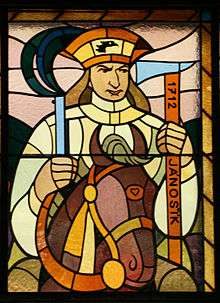Social banditry
Social banditry or social crime is a popular form of lower class social resistance involving behavior characterized by law as illegal but is supported by wider (usually peasant) society as being moral and acceptable. The term social bandit was invented by the Marxist historian Eric Hobsbawm in his 1959 book Primitive Rebels and 1969 book Bandits. Hobsbawm characterized social banditry as a primitive form of class struggle and class resistance in usually pre-industrial and frontier societies. He further expanded the field in the 1969 study Bandits. Social banditry is a widespread phenomenon that has occurred in many societies throughout recorded history, and forms of social banditry still exist, as evidenced by piracy and organized crime syndicates. Later social scientists have also discussed the term's applicability to more modern forms of crime, like street gangs and the economy associated with the trade in illegal drugs.


Eric Hobsbawm
Hobsbawm's key thesis was that outlaws were individuals living on the edges of rural societies by robbing and plundering, who are often seen by ordinary people as heroes or beacons of popular resistance. He called it a form of "pre-historic social movement", by contrast with the organized labour movement. Hobsbawm's book discusses the bandit as a symbol, and mediated idea, and some of the outlaws he refers to are Pancho Villa, Lampião,[1] Ned Kelly, Dick Turpin, Juraj Jánošík, Sándor Rózsa, Billy the Kid[2] and Carmine Crocco, among others.[3] The colloquial sense of an outlaw as bandit or brigand is the subject of the following passage by Hobsbawm:[4]
The point about social bandits is that they are peasant outlaws whom the lord and state regard as criminals, but who remain within peasant society, and are considered by their people as heroes, as champions, avengers, fighters for justice, perhaps even leaders of liberation, and in any case as men to be admired, helped and supported. This relation between the ordinary peasant and the rebel, outlaw and robber is what makes social banditry interesting and significant ... Social banditry of this kind is one of the most universal social phenomena known to history.
Criticism
Historians and anthropologists such as John S. Koliopoulos and Paul Sant Cassia have criticised the social bandit theory, emphasising the frequent use of bandits as armatoloi by Ottoman authorities in suppressing the peasantry in defence of the central state. Sant Cassia observed of Mediterranean bandits that they "are often romanticized afterward through nationalistic rhetoric and texts which circulate and have a life of their own, giving them a permanence and potency which transcends their localized domain and transitory nature".[5] In Hobsbawm's case, the romanticisation was political rather than nationalistic, yet the fluid, ambiguous figure of the bandit remains.[6]
See also
- Robin Hood
- Brigandage in the Two Sicilies, peasant rebellion developed in southern Italy in the early 19th century
- Dacoity, Indian bandits who portrayed themselves (and were portrayed by the media) as social bandits[7]
- Expropriative anarchism, practice of robbery and scams in Argentina and Spain
- Illegalism, anarchist philosophy which openly embraced criminality
- Cangaço, social banditry in Northeast Region, Brazil
- Hajduk, outlaws in Central and Eastern Europe
- Betyárs, social bandits in Kingdom of Hungary
- Klepht, anti-Ottoman insurgents in Greece and Cyprus
- Narcocorrido, Mexican music from the norteño folk corrido tradition
- Rapparee, Irish guerrillas during the 1690s Williamite war
- Uskoks, Croatian Habsburg soldiers during the Ottoman wars in Europe
- Abrek, Anti-Cossack/Russian guerilla raiders in the North Caucasus, especially Chechnya
References
- Seal, Graham. "Outlaw Heroes in Myth and History" Anthem Press, 2011. ISBN 9780857287922. Pages 3 & 181.
- Hobsbawn, Eric J. (1959). Primitive Rebels: Studies in Archaic Forms of Social Movement in the 19th and 20th Centuries. WW Norton. pp. 13–29.
- Eric J. Hobsbawm, Bandits, Penguin, 1985, p.25
- Bandits, E J Hobsbawm, Pelican 1972. Revised ed, Weidenfeld & Nicolson, 2001. ISBN 978-0-349-11302-9
- Cassia, Paul Sant (October 1993). "Banditry, Myth, and Terror in Cyprus and Other Mediterranean Societies." Comparative Studies in Society and History 35, no. 4
- Patrick Fuliang Shan, “Insecurity, Outlawry and Social Order: Banditry in China‟s Heilongjiang Frontier Region, 1900- 1931,” Journal of Social History, Fall 2006, pp.25-54.
- Paul Salopek (6 February 2019). "Trekking India's wild north, where bandits ruled". National Geographic. Retrieved 7 February 2019.
Further reading
- Benedetto Croce, Angelillo (Angelo Duca). Capo di banditi, 1892
- Hobsbawm, Eric (1965). Primitive Rebels.
- Hobsbawm, Eric (1969). Bandits.
- Lea, John (August 1999). "Social crime revisited". Theoretical Criminology. 3 (3). Archived from the original on 12 October 2002.